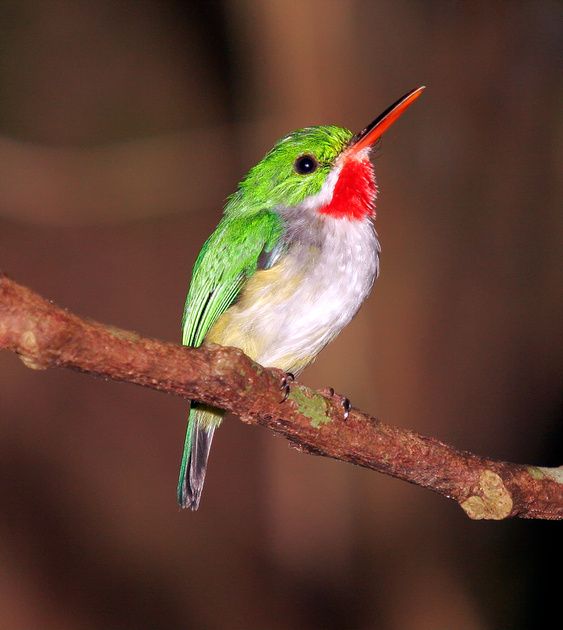The bobolink (Dolichonyx oryzivorus) is a small New World blackbird and the only member of the genus Dolichonyx. An old name for this species is the “rice bird”, from its tendency to feed on cultivated grains during winter and migration. The bobolink breeds in the summer in the United States and Canada, with most of the summer range in the northern U.S. Bobolinks winter in southern South America, primarily Paraguay, Argentina, and Bolivia. Breeding male Bobolinks are mostly black with a white back and rump, and a rich buffy nape. Females and nonbreeding males are warm buffy brown, streaked with dark brown on the back and flanks. They have bold brown stripes on the crown but are unstreaked on the nape of the neck. The bill is pinkish.
Bobolinks breed in open areas across the northern United States and southern Canada, preferring large fields with a mixture of grasses and broad-leaved plants like legumes and dandelions. They formerly nested mainly in tallgrass and mixed prairie of the midwestern United States and south-central Canada. They now also nest in eastern hayfields and meadows, which became available as eastern forests were cleared, and west of the Great Plains in recently irrigated habitats. After breeding, Bobolinks move to freshwater marshes and coastal areas to molt before migrating. Their main wintering area is in the southern interior of South America, where they spend their time in grasslands, marshes, rice fields, and sorghum fields.
Bobolinks are polygynous, meaning each male mates with several females per breeding season. But they are also polyandrous, with each clutch of eggs laid by a single female often representing multiple fathers. Outside of the nesting season Bobolinks live socially in flocks. After arriving on the breeding grounds males compete vigorously for territories by singing, displaying, fighting, and chasing each other. Within the male’s territory, the female chooses a nest site on the ground, usually on wet soil at the base of large nonwoody plants like meadow rue, golden alexander, or clover. The female gathers materials from within about 100 yards of the nest and builds the nest by herself in 1–2 days. She starts the nest by plucking bare a patch of soil and making a depression. She weaves a floorless outer wall of coarse dead grasses and weed stems, then lines the inside by placing fine grasses and sedges directly on the soil. She may continue adding lining material after laying the first egg. The inside of the nest measures 2.4-4.3 inches across and up to 2 inches deep. In the male’s primary nest, both parents feed the young, and in his secondary nests he may help with feeding to varying degrees. In some nests, the nestlings are fed by more than two attending adults, which possibly include multiple fathers or offspring from the previous year. The young leave the nest unable to fly, and hide in thick vegetation for a few more days until their flight feathers have fully emerged. Families from several nests join together and form foraging flocks. Within about a month the immature birds learn to feed themselves, and the flock departs the breeding grounds soon afterward.
During the breeding season, Bobolinks eat weed seeds, insect larvae, adult insects, spiders, and other arachnids. They feed their protein-dependent nestlings with invertebrates exclusively. They forage for seeds at the tops of nonwoody plants, often perching on the plant itself while extracting the seeds slowly and carefully. They glean insects and spiders closer to the base of the vegetation. During migration and winter, Bobolinks eat wild and domesticated rice, oats, other small grains, corn, tassels, weed seeds, and occasional insects. Normally daytime foragers, they may feed after dark on bright nights during migration, to build fat reserves for their long flight over the Gulf of Mexico and the Caribbean. Adult bobolinks are preyed on by cooper’s hawks, northern harriers, and merlins. Bobolink eggs and nestlings are eaten by garter snakes, sandhill cranes, crows, skunks, thirteen-lined ground squirrels, cats, and dogs.
The male sings a metallic, bubbly, rambling song with a mixture of sharp high notes and buzzy low pitches. He sings from perches and in flight throughout the breeding season, but mostly while establishing a territory and courting females. Each male has 2 song types, each composed of 25–50 notes in a fixed sequence, lasting about 3.5 seconds. Bobolinks use a pink sound all year round to communicate within flocks, and they have several additional calls during the breeding season. Males give chunk, chenk, and see-yew calls when disturbed by intruders, buzzes during courtship display, and staccato check notes while pursuing other males. Females respond to intruders with chunk and quipt notes, and use quiet zeep notes when conflicting with other individuals. Here is a link so that you can listen to this bird too.

